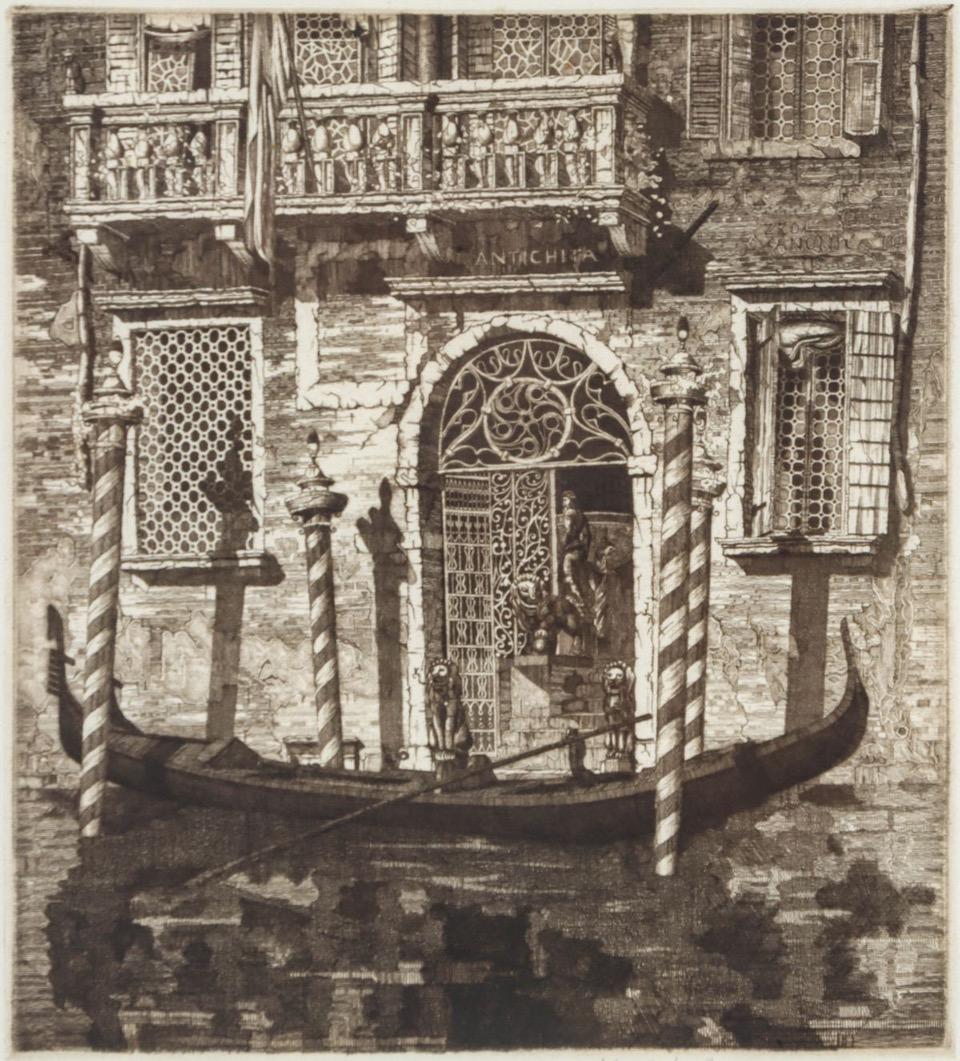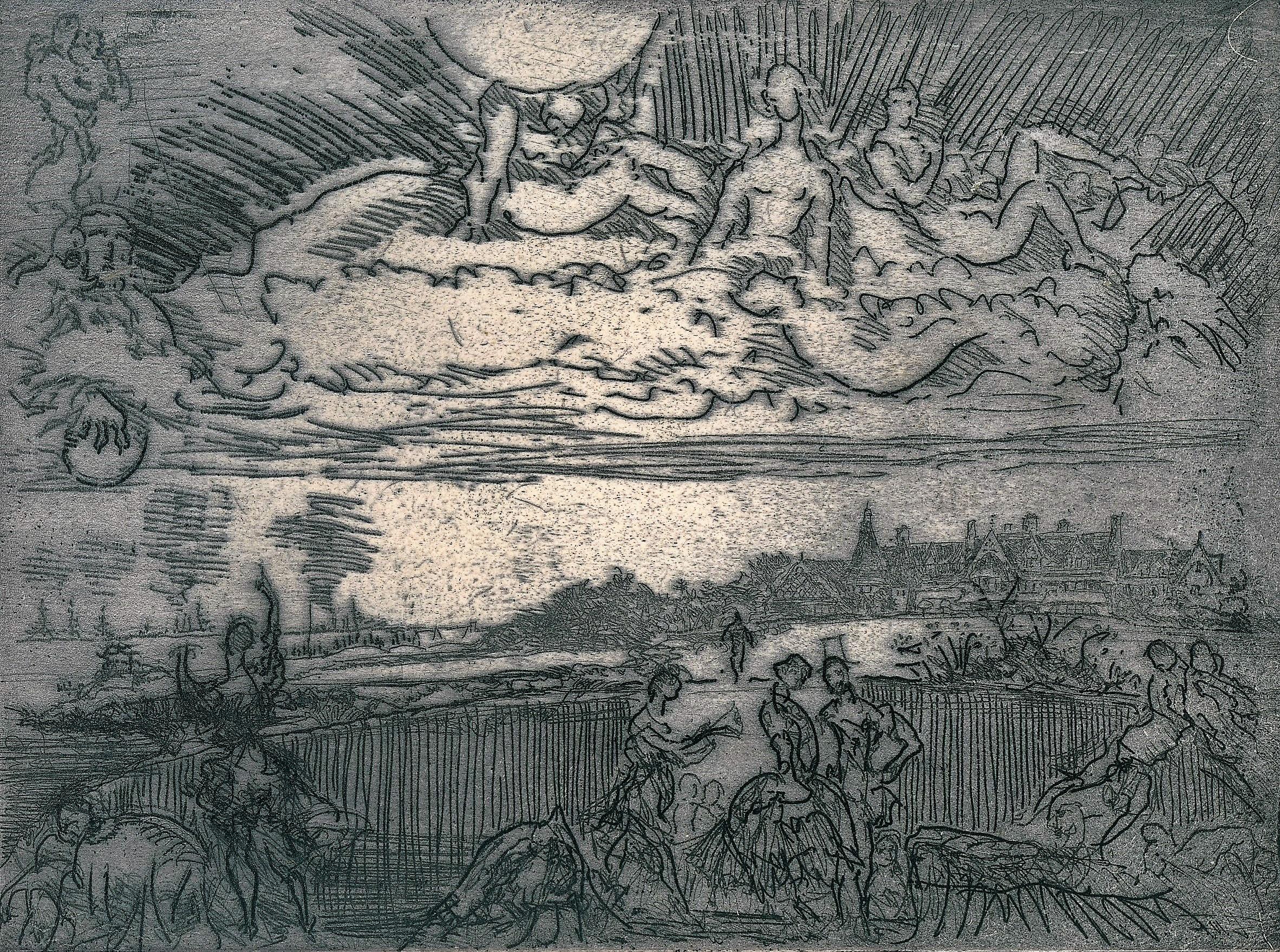Articles similaires à L'Esprit gothique
Vous voulez plus d'images ou de vidéos ?
Demander au vendeur plus d'images ou de vidéos
1 sur 5
John Taylor ArmsL'Esprit gothique1922
1922
À propos de cet article
The Gothic Spirit (also called A Gargoyle, A Gothic Spirit). 1922. Etching and stipple. Fletcher 120. 11 5/8 x 7 (sheet 15 1/4 x 11 1/4). Gargoyle Series #8. Edition 130. Illustrated: Print Collector's Quarterly 21 (1934):126; American Etchers: John Taylor Arms. A glowing impression printed on Japanese mulberry paper with deckle edges on two sides. Signé au crayon. Présentée dans un carton de montage de 50,8 x 40,64 cm, adapté à l'encadrement.
John Tayler Arms was born on April 19, 1887, in Washington D.C., and studied law at Princeton University and then transferred to the Massachusetts Institute of Technology to study architecture, earning a master's degree in 1912. For five years after his graduation, he worked for Carrere and Hastings, an architectural firm and then became a partner in another firm named Clark and Adams.
In 1913, he made his first etching and by 1927 began exhibiting his architectural etchings at the National Arts Club and the Salmagundi Club in New York. He also worked in aquatint and drypoint and often combined the three methods. In addition to medieval architecture, he etched scenes of Maine and a series of American cities.
Arms became one of the most famous printmakers of the early 20th century. He was known for his medieval architectural etchings that combined precise realism with a sense of soaring spirituality. He believed that Gothic architecture was man's greatest achievement, uniting spiritual and aesthetic values, and was best known for his renderings of gargoyles and European churches. He was remarkably prolific, considering that he worked slowly and deliberately and spent much time traveling, writing, and lecturing. He was a member of principal art organizations including the National Institute of Arts and Letters, and he wrote several books on prints and printmaking including "Handbook on Printmaking and Printmakers."
Arms etched 429 prints before his death on October 15, 1953, at age 66.
John Taylor Arms (1887–1953) is one of the foremost American printmakers of the first half of the 20th century. Trained as an architect, he spent the majority of his 50-year career documenting Europe’s great Gothic churches. Arms believed that art could be a tool for the spiritual and moral improvement of mankind and that Gothic cathedrals represented “the most significant expression of man’s aspirations.” He viewed printmaking as a vehicle for disseminating images of subjects that would uplift and inspire contemporary society.
- Créateur:John Taylor Arms (1887 - 1953, Américain)
- Année de création:1922
- Dimensions:Hauteur : 29,55 cm (11,63 po)Largeur : 17,78 cm (7 po)Profondeur : 1,27 cm (0,5 po)
- Support:
- Mouvement et style:
- Période:
- État:
- Adresse de la galerie:Storrs, CT
- Numéro de référence:1stDibs : LU33528476332
À propos du vendeur
5,0
Vendeur reconnu
Ces vendeurs prestigieux sont des leaders du secteur. Ils représentent le summum en matière de qualité et de design.
Vendeur Platine
agréés par des experts, ces vendeurs sont les plus expérimentés sur 1stDibs et les mieux notés par nos clients.
Établi en 1977
Vendeur 1stDibs depuis 2016
699 ventes sur 1stDibs
Temps de réponse habituel : 1 heure
Associations
International Fine Print Dealers Association
- ExpéditionRecherche du devis...Expédition à partir de : Storrs, CT
- Politique des retoursCet article peut être retourné sous 3 jours à compter de la date de livraison.
Certaines parties de cette page ont été traduites automatiquement. 1stDibs ne garantit pas l'exactitude des traductions. L'anglais est la langue par défaut de ce site web.
Plus d'articles de ce vendeurTout afficher
- Caprice, ou House on Cliff Walk, Newport, Rhode Island (Rhode Island)Par Clifford Isaac AddamsHouse on Cliff Walk, Newport, Rhode Island ou Caprice, Newport, Rhode Island. 1931/33. Aquarelle. Catalogue Hausberg 138 état ii. 5 15/16 x 8 (feuille 7 7/8 x 9 5/8). Une riche impr...Catégorie
Milieu du XXe siècle, Modernisme américain, Estampes - Paysage
MatériauxPointe sèche, Eau-forte
- Bailey's Beach, Newport, Rhode Island (Royaume-Uni).Par Clifford Isaac AddamsBailey's Beach (Newport, Rhode Island). c. 1931-1933. Eau-forte et pointe sèche. Catalogue Hausberg 126 état vi. Edition 75. 6 x 7 7/8 (feuille 9 9/16 x 12 1/2). Imprimé sur du papie...Catégorie
Milieu du XXe siècle, Modernisme américain, Estampes - Paysage
MatériauxPointe sèche, Eau-forte
- Plage de Bailey, Newport, Rhode Island.Par Clifford Isaac AddamsPlage de Bailey (Newport, Rhode Island). 1933. Eau-forte. Hausberg 126 état v/vi. Édition 75. 6 x 7 7/8 (feuille 9 3/8 x 12 3/8). Imprimé avec de nombreux tons à la planche sur du pa...Catégorie
Milieu du XXe siècle, Modernisme américain, Estampes - Paysage
MatériauxPointe sèche, Eau-forte
- Jeune nuit de printemps, Greenwich VillagePar Martin LewisNuit de printemps, Greenwich Village. 1930. Pointe sèche et fond de sable. McCarron 85. 10 x 12 3/8 (feuille 13 1/4 x 15 5/8)). Édition 92. Une impression riche en tonalités, imprimé...Catégorie
années 1930, Modernisme américain, Estampes - Figuratif
MatériauxPointe sèche, Eau-forte
- La rue muralePar Joseph PennellWall Street. 1904. Aquarelle. Wuerth 344. 11 3/4 x 7 7/16 (feuille 15 1/2 x 10 1/4). Edition d'environ 75 exemplaires. Une impression riche en tonalités, imprimée sur du papier mûrie...Catégorie
Début du 20ème siècle, Modernisme américain, Estampes - Paysage
MatériauxPointe sèche, Eau-forte
- Stoops dans la neigePar Martin LewisStoops dans la neige. 1930. Pointe sèche et fond de papier de verre. Catalogue McCarron 89.état ii. 9 x 14 7/8 (feuille 13 1/4 x 18 7/16 ). . Édition 115 impressions enregistrées. I...Catégorie
années 1930, Modernisme américain, Estampes - Figuratif
MatériauxPointe sèche, Eau-forte
Suggestions
- Gardiens de la flèche ; cathédrale Amiens numéro 2Par John Taylor ArmsLes gardiens de la flèche ; cathédrale d'Amiens numéro 2 New York : 1937. Gravure et pointe sèche sur F.J. en filigrane. Tête de couleur crème, papier vergé ancien, 6 3/4 x 9 7/8 in...Catégorie
Milieu du XXe siècle, Modernisme américain, Estampes - Figuratif
MatériauxPointe sèche, Eau-forte
- Palazzo dell'AngeloPar John Taylor ArmsPalazzo dell'Angelo 1931 Gravure à l'eau-forte et pointe sèche sur papier vergé de couleur crème, fait à la main, avec bords rognés, 185 x 171 mm, édition de 100, marges complètes. ...Catégorie
Années 1930, Modernisme américain, Estampes - Figuratif
MatériauxPointe sèche, Eau-forte
- Des marches au Grand Canal, St. Mark's au loin, Venise.Par Donald Shaw MacLaughlanUne belle vue de Venise depuis l'eau. Gravure à l'eau-forte et à la pointe sèche sur papier vergé crème ancien avec un grand filigrane figuratif, signée au crayon en bas à droite. 14...Catégorie
Début du 20ème siècle, Modernisme américain, Estampes - Paysage
MatériauxPapier vergé, Pointe sèche, Eau-forte
- Remorqueurs sur l'HudsonPar Charles Frederick William MielatzGravure à la pointe sèche avec gravure imprimée à l'encre noire sur papier mûrier japonais, 4 1/2 x 3 3/8 pouces (113 x 84 mm), marges complètes. En superbe état. Un magnifique paysa...Catégorie
Début du 20ème siècle, Modernisme américain, Estampes - Paysage
MatériauxPapier fait main, Pointe sèche, Eau-forte
- Danse de la Comanche, Ildefonso Pueblo, Nouveau-Mexique, eau-forte encadréePar Gene KlossDanse comanche à San Ildefonso Pueblo (Nouveau Mexique). Gravure et pointe sèche, épreuve d'artiste d'une édition de 50 tirages. Présenté dans un cadre personnalisé, les dimensions ...Catégorie
années 1980, Modernisme américain, Estampes - Figuratif
MatériauxPointe sèche, Eau-forte
- The Old Smyth Gate, Charleston, Caroline du SudPar Alfred HuttyVue de la porte d'entrée de la maison Simmons-Edwards (14 Legare Street), également connue sous le nom de Pineapple Gate House. Gravure à la pointe sèche sur papier vergé filigrané ...Catégorie
Début du 20ème siècle, Modernisme américain, Estampes - Paysage
MatériauxPapier vergé, Pointe sèche, Eau-forte, Papier fait main





